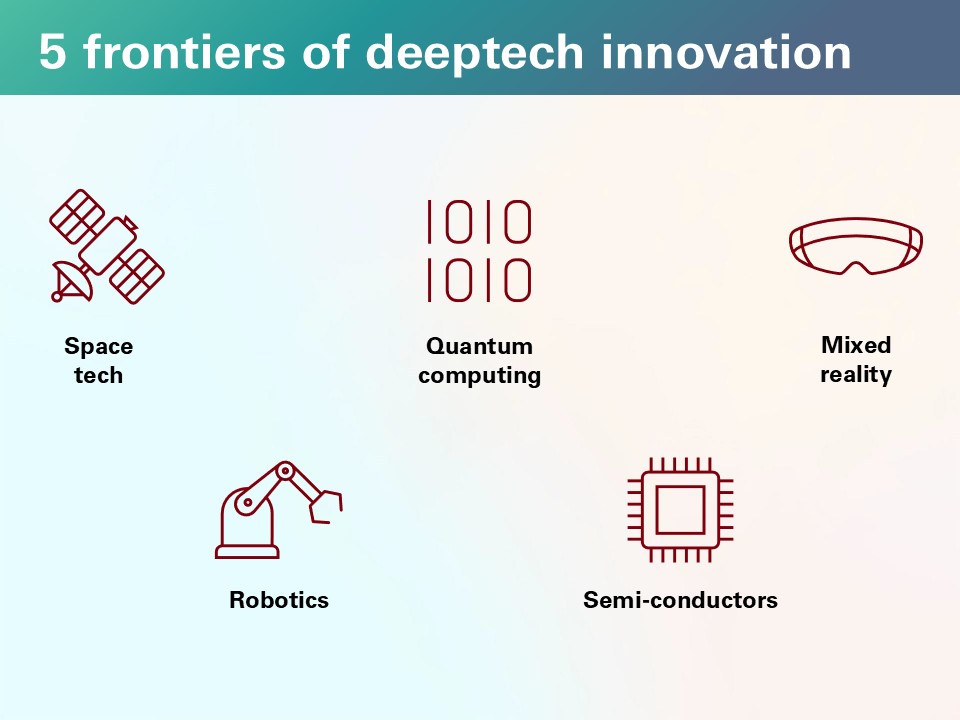Demystifying deep tech: Capital, capability and conditions for growth
- Innovation
- Article
- 8 minutes read

Bill Gates, Founder, Microsoft"Software is more important than hardware."
For all the attention software has received over the past two decades, I believe we may be entering an era where groundbreaking hardware is pushing the limits of science, mathematics, engineering and logic.
Finally, deep tech is having its day in the sun as it defines entirely new industries and solutions to humanity’s most pressing challenges.
Investors are taking notice too, and the sector is showing surprising resilience to market cycles. In fact, Dealroom data shows that the sector now commands nearly one-third of all venture capital in Europe in 20251.
In the UK alone, deep tech companies raised £8.8 billion in 20232 across 1,346 transactions3.
But what exactly is deep tech, how is it different from software innovation, and what are the factors driving growth across a sector that has historically been viewed as cumbersome and capital intensive?
Deep tech is often defined using terms that sound like the come straight from science fiction, but put simply, it’s a term applied to novel technology built on scientific discovery or meaningful engineering innovation.
To distil it even further, it’s best understood as hardware-focused innovation that creates tangible products that change how we interact with the world.
Of course software and hardware go hand-in-hand, but unlike the code that underpins software development, deep tech is focused on the machines and mechanisms that make new realities possible.
Think Quantinuum developing quantum computers that will revolutionise encryption, or XYZ bringing mixed reality headsets into the construction space.
The spectrum of innovation in the deep tech arena is vast, but can be loosely grouped into 5 verticals: space tech, quantum computing, robotics, augmented/mixed reality, and semiconductors.

Although new developments in deep tech are incredible feats of engineering in their own right, the reason why deep tech is particularly exciting today is because many of these technologies are maturing simultaneously.
This convergence creates opportunities to reshape industries and solve problems previously considered impossible by creating powerful feedback loops that accelerate innovation across sectors.
Rapberry Pi’s small single-board computers are a good example. Initially developed to make it easier to teach school children computer science, the hardware is now driving change across a range of diverse sectors like manufacturing, industry, health care, agriculture and transport.
Ian Newton, Head of Business Development, Raspberry Pi"Raspberry Pi computers permeate multiple sectors, providing inter-scalability by enabling innovation by offering cost-efficient, flexible computer power focused on connectivity, all manufactured within the UK."
Similar advances across the deep tech are enabling other industries to advance, which has captured the attention of investors.
While traditional software-only technology revolves around speed, scale and iteration, deep tech companies build on fundamental scientific or engineering advances, often involving tangible hardware.
Naturally that means development cycles take longer, upfront investment is heavier and commercial timelines are challenging to predict. But, this innovation also means the technologies are more difficult to replicate and thus more resilient.
Dealroom data shows European deep tech startups take two to three times longer to reach Series A compared to their software as a service (SaaS) peers, but once they do, they are more likely to secure follow-on funding1.
Despite the common misconception that deep tech companies fail more often than their SaaS counterparts, recent activity suggests that investors are increasingly comfortable with the sector’s unique risk profile.
Take quantum computing: in 2024, over €1.2 billion in public and private funding flowed into European quantum startups alone1. Similarly, the 2023 OneWeb-Eutelsat merger, valued at $3.4 billion, showed space tech has become a strategically important and investable sector.
For years, venture capital kept its distance from hardware-heavy businesses, but this data suggests that’s no longer the case. As development becomes cheaper and technologies converge, deep tech is attracting institutional, strategic and non-traditional capital.
So how might deep tech leaders use this knowledge to accelerate their own growth?
Several factors are aligning to make deep tech more viable and urgent than ever before. Development costs are falling. Core technologies like AI, advanced materials and chip architectures are maturing. The shifting geopolitical landscape means institutions worldwide are re-assessing who builds what, where and why.
Let’s explore these factors in a little more detail.
Cost and capability
Hardware-led innovation has always required more capital, time and infrastructure than software. But the barriers are starting to lower. Grants, academic partnerships, infrastructure access and early-stage capital are becoming more available.
Meanwhile, AI is accelerating R&D across materials, chemistry and modelling. Foundational infrastructure, from advanced chip architectures to enabling hardware, has matured to a point where companies can build faster and de-risk earlier. What was once too slow or speculative is becoming technically and commercially viable.
The ecosystem around deep tech has changed, too. The UK now has a pipeline of deep tech ventures reaching scale, not just early-stage research projects. In the first half of 2024, nearly one-third of venture funding in the sector went to later-stage rounds2. More experienced operators and repeat founders are starting to enter the space, and increasingly, engineering talent is leaving academia for venture-backed companies.
Industry and infrastructure
At the same time, national priorities have shifted, and deep tech is now tied directly to domestic industrial strategy.
In the UK, this is reflected in significant public funding: £20.4 billion committed to R&D in the 2024 Budget, alongside new regulatory frameworks and sector-specific manufacturing support.
Infrastructure access has also improved. Take SaxaVord, the UK’s first vertical launch spaceport, which is preparing to support commercial satellite launches from the Shetland Islands.
"The construction and licensing of the UKs first licenced vertical launch facility in line with the UK Governments stated aim to become a technology and science superpower will encourage young progressive technology companies to reach into the Space Industry and build and develop their businesses in the fastest growing sector in the World at the moment," said CEO and Founder Frank Strang.
Frank Strang, CEO and Founder, SaxaVord Spaceport"We see ourselves as an enabler and springboard for growth as well as supporting launch activity from sovereign soil."
Together, these macro shifts in capability, capital and national strategy have created the conditions for a new wave of deep tech ventures to emerge with clearer roadmaps, stronger support and a better chance of scaling.
The key to unlocking that opportunity is to understand what investors are responding to and why that’s the case.
Deep tech has attracted record funding in recent years1, but it’s not enough for teams to show technical ambition alone.
Ensure early alignment
With sharp scrutiny on how capital is deployed, the key is to show alignment early on: between R&D and commercial milestones, founder vision and investor expectations, and complex technology and clear roadmaps.
Companies raising successfully are able to demonstrate early commercial judgement and the ability to adjust strategy without diluting technical focus.
Set meaningful progress milestones
Another important factor for investors is to understand how progress will be measured. Although they may not need to see a finished product, tangible proof points like a working prototype, an industry partnership, customer research, or regulatory validation are comforting, concrete steps show that innovation can translate to real products.
Protect against medium- and long-term risk
Understanding risk matters, too. In sectors like space tech, it’s not unusual to see a small number of high-value contracts making up the bulk of early revenue. Founders who show a plan for diversification or who can explain the durability of those contracts may be able to avoid common friction points during due diligence.
Demonstrate capital efficiency
How you spend money matters just as much as how much you raise. For hardware-intensive businesses, burn rates can be steep, but discipline and transparency around spend make a difference. Companies that can explain their capital expenditure strategy, show when costs will decrease, and how value builds over time tend to find better-aligned investors.
Signalling to investors that the business is viable and exploring a blended capital stack can put deep techs in a powerful position. Finnish scale up ICEYE, who design and manufacture high-fidelity earth observation satellites using Synthetic Aperture Radar ("SAR") imaging as its core technology, have used a mix of debt and equity to accelerate at speed.
John Lauria, Global Head of Treasury, ICEYE"ICEYE has raised equity and debt funding from institutional investors and counts several marquee names in its capital structure. ICEYE closed a $136M Series D funding round in February 2022 and a $158M growth funding round consisting of debt and equity in 2024. As of year-end 2024 ICEYE has raised over $500M."
Although tangible outcomes, measurable milestones and efficient use of capital are important, talent is perhaps the most important signal for investors.
In deep tech, the presence of strong technical hires and the ability to retain them are often seen as indicators of delivery capability.
Having a CTO or engineering lead with a track record in complex builds can shortcut a lot of perceived risk, as can hiring top-notch non-technical hires with commercial and/or operational expertise, even if the product isn’t live yet.
Ian Newton, Head of Business Development, Raspberry Pi"The IPO has supported the business in attracting more quality engineers to work with us. We also benefitted from being able to raise debt (greater access to growth capital) to further scale the business and was instrumental on raising the company’s brand awareness."
Ultimately, investors in deep tech are looking for teams that balance scientific excellence with commercial pragmatism – and the ability to attract the very best engineering minds is a vital sign of potential success.
While software continues to dominate digital column inches, deep tech has quietly reached a crucial tipping point.
With key technologies maturing, and applicability across multiple sectors, many scale-ups that are focused on building tangible technology products are poised to enjoy growing investor interest.
By demonstrating sound commercial principles and a solid roadmap, leaders in the space will be able to show value to investors, and attract the kind of talent needed to elevate their offering even further.
Don’t sleep on deep tech: it’s set to deliver extraordinary opportunity.
Our deepest condolences to the family, friends and colleagues of Frank Strang, who passed away shortly after this article was published.
Any opinions expressed are merely opinions and not facts. All information in this document is for general informational purposes and not to be construed as professional advice or to create a professional relationship and the information is not intended as a substitute for professional advice. Nothing in this document takes into account your company’s individual circumstances. HSBC Innovation Banking does not make any representations or warranties with respect to the accuracy, applicability, fitness or completeness of this document and the material may not reflect the most current legal or regulatory developments. HSBC Innovation Banking disclaims all liability in respect to actions taken or not taken based on any or all of the contents in this document to the fullest extent permitted by law. Nothing relating to this material should be construed as a solicitation or offer, or recommendation, to acquire or dispose of any investment or to engage in any other transaction.